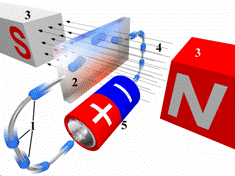Categories: Interesting Facts, Controversial issues
Number of views: 25077
Comments on the article: 2
Mysteries of Crossed Currents - Hall Effect
 At the end of the last century, a young American physics student Edwin Hall made a discovery that wrote his name in physics textbooks. He conducted a simple, “student” experiment — he studied the propagation of current in a thin metal plate placed between the poles of a strong electromagnet. Students of all universities undergo laboratory practice, where they are taught with simple examples the skill of the experiment. So it was this time. A humble student could not have imagined that his simple experience would give rise to an avalanche of research, some of which will be marked by the most honorable scientific award - the Nobel Prize.
At the end of the last century, a young American physics student Edwin Hall made a discovery that wrote his name in physics textbooks. He conducted a simple, “student” experiment — he studied the propagation of current in a thin metal plate placed between the poles of a strong electromagnet. Students of all universities undergo laboratory practice, where they are taught with simple examples the skill of the experiment. So it was this time. A humble student could not have imagined that his simple experience would give rise to an avalanche of research, some of which will be marked by the most honorable scientific award - the Nobel Prize.
The device with which Hall worked consisted of two crosswise arranged electrical circuits - this is how they tie up boxes of sweets with a ribbon. The chains differed in that one of them contained an electric battery and the current from it passed along the plate, the other, transverse, had no current sources and simply connected the edges of the plate.
As expected, in the case when the electromagnet was turned off, the instruments recorded the current flow only along the plate — in the circuit with the battery — and its absence in the “empty” transverse circuit. No wonder. However, as soon as the electromagnet turned on, in the transverse circuit, as if from nothing, an electric current appeared on its own. It was interesting, but there was no miracle here - an explanation was found quite quickly. Electrons moving in a longitudinal chain are affected by the Lorentz force, well known from the school textbook, which deflects electrons in the transverse direction, which generated a small current in the transverse chain - everything is elementary simple.
For more than half a century, half-forgotten, this phenomenon has remained in the rear of physical science. Dug it in the archives by specialists in microelectronics. At first it turned out that if the coarse measuring devices of the Hall time were replaced with modern ones, then the phenomenon discovered by him could be used to count the number of charged particles whose movement generates an electric current, which is very important for designers of low-noise transistors and other highly sensitive microelectronic devices working with very weak currents and magnetic fields.
The Hall effect was carefully studied, sparing no effort to improve accuracy. The third, fourth, fifth decimal place on the scales of measuring instruments ... And here amazing, at first glance, simply incredible phenomena began to appear.
The first amazing result was obtained twenty years ago, at the end of the seventies, in experiments with semiconductor circuits in a strong magnetic field at very low temperatures, only a few degrees away from "absolute zero" - 273 degrees Celsius, when the substance freezes so much that cease, all molecular movements freeze. So, if at ordinary temperatures close to room temperature, the electrical resistance in the circuit with the “Hall current” gradually increases with increasing magnetic field, then for some reason near the temperature zero it changes stepwise - as if a smooth path along which current particles move, suddenly gives way to a paved with deep bumps. The smooth curves that the recorders wrote out are replaced intermittently by a “ladder”, the height of the steps of which was equal to some constant divided by integers n = 1, 2, 3, and so on.
And what is even more surprising - at each stage the resistance in the longitudinal current circuit drops to zero, that is, for the longitudinal current the substance becomes a superconductor - the electrons roll without any resistance, but at the joints, when moving from one stage to another, the resistance jumps sharply and superconductivity instantly disappears.All this looked like some kind of confusion - as they say, everything was mixed up in the Oblonsky house!
How to explain such a strange behavior of crossed currents? Why do they behave in completely different ways? Electrodynamics turned out to be powerless in front of this riddle ... We are accustomed to the fact that mysterious phenomena occur in complex experiments with elementary particles or deep in space when it comes to black holes, exploding galaxies and other objects that amaze our imagination, and here are just experiments with resistance and currents. Along and across the groomed area and - on you!
V. Barashenkov, E. Kapustsik
See also at bgv.electricianexp.com
:

